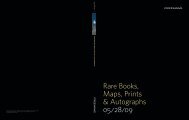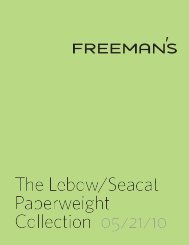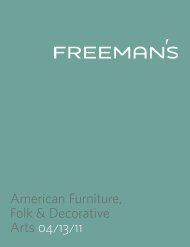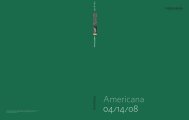Fine American & European Paintings & Sculpture 12/02/12
Fine American & European Paintings & Sculpture 12/02/12
Fine American & European Paintings & Sculpture 12/02/12
Create successful ePaper yourself
Turn your PDF publications into a flip-book with our unique Google optimized e-Paper software.
114 <strong>12</strong>8044/1<br />
CARL CLEMENS MORITZ RUNGIUS<br />
(american 1869-1959)<br />
GRIZZLY BEAR<br />
Signed ‘C. Rungius’ bottom right, oil on<br />
canvas, unframed<br />
30 x 40 in. (76.2 x 101.6cm)<br />
provenance:<br />
Private Collection, Virginia.<br />
$200,000-300,000<br />
Considered the first wildlife painter<br />
in America, Carl Rungius (1869-<br />
1959) was both a sportsman and an<br />
artist who depicted animals in their<br />
natural environs. A native of Rixdorf,<br />
Germany – now present-day Berlin –<br />
he had a keen interest in nature and<br />
art from an early age, particularly<br />
that of the <strong>American</strong> West. Its vast,<br />
uncharted territory would present<br />
Rungius with greater opportunities<br />
to both hunt and paint, and a<br />
fortuitous invitation from his uncle<br />
to travel to America was pivotal in<br />
shaping his career. Eventually<br />
becoming a prolific and celebrated<br />
artist, much in the tradition of the<br />
Hudson River painters who<br />
preceded him, he glorified the<br />
<strong>American</strong> landscape. Rungius also<br />
became a champion of the<br />
conservation movement, and was<br />
pitted against the forces of late<br />
19th-century Western<br />
expansionism.<br />
After immigrating to the Unites<br />
States in 1896, Rungius maintained<br />
a New York studio while he travelled<br />
extensively throughout Yellowstone,<br />
Wyoming, Montana, Alaska and the<br />
Yukon, eventually establishing a<br />
summer studio in Banff, Alberta in<br />
1922, known as ‘The Paintbox’.<br />
Following in the tradition of the<br />
plein-air painters of the 19th and<br />
20th-centuries, Rungius dutifully<br />
studied and recorded his subjects,<br />
revealing not only a great love and<br />
respect for nature and its<br />
inhabitants, but a concern for<br />
depicting animals and landscapes<br />
with fidelity. As such, it is not<br />
surprising that he enjoyed a<br />
successful career as an illustrator of<br />
books, magazines and other<br />
material promoting conservation<br />
and the support of endangered<br />
animals.<br />
Rungius was not alone in his<br />
portrayal of animals; a century<br />
earlier, sporting artists of Britain<br />
achieved notoriety in painting<br />
equine-themed subjects, including<br />
thoroughbreds and racehorses.<br />
However, in such pictures, while the<br />
animals are portrayed realistically<br />
and in a dignified manner, they are<br />
rarely depicted in their natural<br />
environments. Instead, whether with<br />
a jockey up or with a groom, to<br />
name but two common themes of<br />
the period, the horses’ identities and<br />
importance are both inseparable<br />
from, and justified by, the existence<br />
of sportsmen in full racing/hunting<br />
regalia. In 19th-century Britain, and<br />
to a lesser extent parts of the<br />
Continent, the worth of an animal is<br />
directly tied to its owner, with the<br />
latter viewing the former almost<br />
strictly as an instrument providing<br />
commerce and social standing.<br />
Rungius, along with many wildlife<br />
painters he would later influence,<br />
69<br />
free≤an’s<br />
fine american & european paintings & sculpture<br />
<strong>12</strong>/<strong>02</strong>/<strong>12</strong><br />
very rarely included humans in his<br />
paintings, for to do so would be<br />
wholly antithetical to his idyllic<br />
depictions, unspoiled by humans<br />
and their encroachment on nature.<br />
We are pleased to offer this Rungius<br />
painting depicting a stately grizzly<br />
bear. Immortalized on canvas, this<br />
impressive creature joins his many<br />
other works of moose, big horn<br />
sheep, caribou, mountain goats,<br />
pack horses, and antelope, all<br />
capturing the spirit and beauty of<br />
magnificent animals in the precious<br />
natural and threatened world they<br />
inhabit.

















